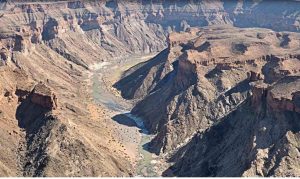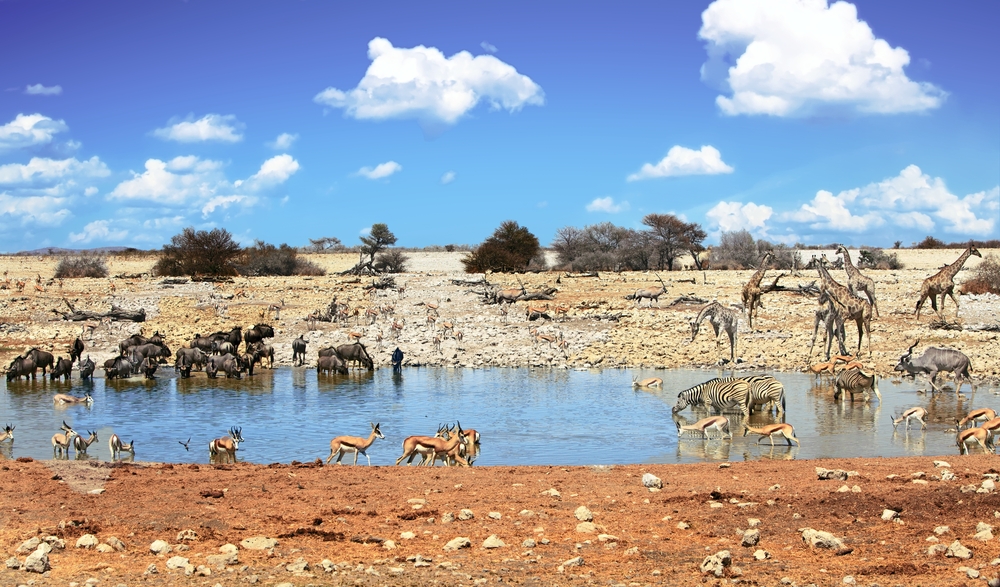Positioned toward the southern region of Africa, Namibia is a land of sunshine and sand. It is named after the Namib Desert which is the oldest desert recorded on earth. Although its western coast opens to the Atlantic Ocean, the country is predominantly a dry and barren land consisting of widespread deserts and rocky canyons. Although much of the country is arid, there are plenty of attractions that qualify as natural wonders of Namibia.
The Central Plateau is the only region with soil fit for growing crops and it is where most of the population is residing. There are about 300 days of summer sun with parched winters and rain pouring the heaviest from February to April. Because of the wide, spacious terrain, photographers will find Namibia an ideal place to capture scenic photos ranging from its natural landscapes to its amazing wildlife to its fine cities. You’ll never get tired of experiencing more of the sites this lovely country has to offer.
Lake Otijikoto
The extraordinary story that surrounds the origins of Lake Otijikoto only adds to the beauty of its deep waters. It is found on the northern region of Namibia in the region of Oshikoto close to Tsumeb. The lake is actually a sinkhole. Originally, there was an underground cave, filled with karst formation, hidden below, and through time, its ceiling collapsed and was filled to the brim with water by Namibia’s rainy season.
Lake Otijikoto only reveals a tiny section of the extensive underground lake. Because of its depth, the lake has become a real challenge for scuba divers around the world. They have also discovered artillery, and remnants from the First World War dumped into the water’s depths.
Epupa Falls
Another natural wonder that contrasts the barren geography of Namibia is the Epupa Falls in Kaokoland of the region of Kunene, north of Namibia. The falls are fed by the river of Kunene which drops into a series of waterfalls completely emphasized by the dry and rocky landscape. There are trees that line the surrounding area of the falls which reflect the tropical climate of the region such as palm trees, fig trees, and baobab. The difficulty of reaching this site has made the place quite undisturbed by human activity making the waterfalls a real gem of the country.
Fish River Canyon

Quite an odd name for a rocky canyon, the Fish River Canyon gets its name from the remnant of a river below the impressive canyon itself. What is left of the river are precious pools that only fill up entirely during heavy rains.
The canyon is also a site to behold as it is actually the second largest in the world after the Grand Canyon in Colorado, United States. It is a popular destination in Namibia, hiking along the trail of the canyon has been a common activity by both locals and traveling tourists. As one of the 7 Natural Wonders of Africa, it is easily one of the natural wonders of Namibia.
Damaraland
Bounded by the great deserts of Kalahari and Namib, Damaraland does not pale in comparison when it comes to scenic landscapes. One of the most highlighted sites in this region is the Petrified Forest. These are trees buried by sand and sediments only to be uncovered after millions of years. The Burnt Mountain, which is actually a hill, is also featured in the land. The place where the hill stood was once an ancient lake filled with aquatic life. Layers make the hills upon layers of sand, silt, and limestone baked by magma that flowed from the earth’s surface millions of years ago.
Brandberg Mountain
Deserving recognition as one of the natural wonders of Namibia, Brandberg Mountain is actually also located on the edges of Damaraland. It is the highest mountain in Namibia and is made from granite intrusions. Brandberg means “Fire Mountain” which originated from the blazing colors that splash the western face of the mountain when the sun sets. It is especially known for the ancient rock paintings in its ravines.

